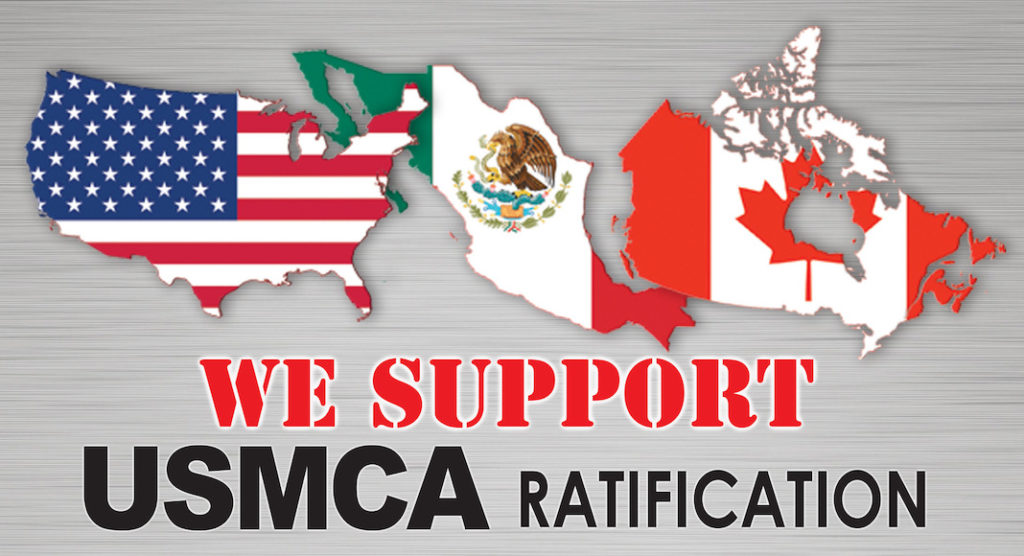
Texas Border Business

Last November at the G-20 Summit in the Costa Salguero Convention Center in Buenos Aires, Argentina, three men sat at a table to sign an important new trade agreement. One was the leader of Mexico, a nation of 123 million, another the leader of 32 million Canadians and the third was the leader of the free world, the president of the United States, a nation of 327 million.
As Nieto, Trudeau, and Trump signed the new United States-Mexico-Canada Agreement (USMCA) many months of long negotiation lay behind them. Negotiations had broken down several times, but in the end, the three great nations of North America were able to agree to a major new trade document that would replace the almost 25-year old North American Free Trade Agreement.
It would seem that the hardest work had been done, right? Apparently not.
Today, the USMCA faces perhaps an even greater challenge: finding bipartisanship in the halls of Congress.
However, if three world leaders representing diverse nations of over 482 million people can come together, then why can’t Congress?
The USMCA is already a tri-national agreement. It must now become a bipartisan one.
The time to act is now. Congressional Republicans and Democrats must come together to approve the USMCA as soon as possible.
NAFTA must be swept away once and for all and replaced with a modern agreement that expands free trade with fairer trade.
NAFTA is like a 25-year-old house in dire need of repairs. Its more than just changing wallpaper or carpet, we need to knock out a few walls and raise the roof.
The USMCA does just that – it keeps what works in NAFTA and replaces what doesn’t.
For example, all food and agricultural products that enjoyed zero tariffs under NAFTA will remain at zero tariffs under the USMCA.
However, since NAFTA did not eliminate all tariffs on agricultural trade between the United States and Canada, the USMCA will create new market access opportunities for United States exports like dairy, poultry
It is the impact on agriculture that represents perhaps the most important reason to sign the USMCA. Canada and Mexico comprise the largest global market for American farmers and ranchers, with farm and food exports valued at more than $39 billion in 2017. Of that, $7.2 billion comes from Texas agricultural exports alone.
Under the USMCA, dairy farmers will have new opportunities to sell their products into Canada, including fluid milk, cream, butter, skim milk powder, cheese
The USMCA will also benefit American poultry producers by allowing new access to Canadian markets for chicken, chicken eggs and increasing access for turkey.
For beef producers, in Texas and across America, the USMCA takes an important step toward ensuring unrestricted and science-based trade and will continue to open up
Under the USMCA, American corn growers will maintain access to their No. 1 customer, Mexico, with a combined market totaling nearly $2.8 billion last year alone.
Finally, the USMCA will have a direct impact on the border region of Texas.
Because the USMCA increases the regional value content requirement for automotive manufacturing from 62 percent under NAFTA to 75 percent that means more carmakers will want to build their operations in Mexico, the U.S. or Canada. However, the USMCA also requires that 40 percent of the value of the vehicle come from a plant that pays $16 an hour, likely pricing out Mexican and Canadian operations. And the best place in the U.S. to build a new plant may be along the Texas-Mexico border for easy access to Mexican ports of entry.
The Texas border with the Mexican state of Tamaulipas is already poised for this growth. I have worked closely with Governor Francisco Javier Cabeza de Vaca over the last three years to improve relations with our neighbor to the south on vital trade and agricultural issues.
For these reasons and so many more, it is time for a bipartisan Congress to ratify the United States-Mexico-Canada Agreement.
American workers, farmers, ranchers
They need the certainty of a trade agreement that replaces NAFTA and moves our trade agreements into the 21st century.
Along that riverfront in Buenos Aires, the leaders of three nations came to the table to agree to a new trading future that will benefit us all.
I am confident that when presented with the benefits to our nation and our American farmers and ranchers, Congressional members from both sides of the aisle can come together and approve the USMCA.
It is time.










